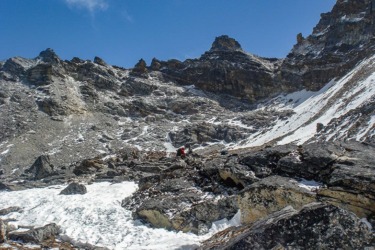

Everest region is inarguably most popular in Nepal for trekking, peak climbing, and mountaineering expeditions. It is the home to the world's most popular Himalayan mountains namely Mt. Everest (8848 m), Mt. Lhotse (8516 m), Mt. Cho Oyu (8201 m), Amadablam (6856 m), Mt. Pumori (7165 m), Mt Thamserku (6608 m), Mt Taboche and many other lesser elevation peaks. Other attractions of this region are the majestic mountains, the villages in the high mountain valleys, Buddhist monasteries, the legendary Sherpa, their culture and lifestyle.
Everest region is inarguably most popular in Nepal for trekking, peak climbing, and mountaineering expeditions. It is the home to the world’s most popular Himalayan mountains namely Mt. Everest (8848 m), Mt. Lhotse (8516 m), Mt. Cho Oyu (8201 m), Amadablam (6856 m), Mt. Pumori (7165 m), Mt Thamserku (6608 m), Mt Taboche and many other lesser elevation peaks. Other attractions of this region are the majestic mountains, the villages in the high mountain valleys, Buddhist monasteries, the legendary Sherpa, their culture and lifestyle.
Upper part of the region lies within Sagarmatha National Park whereas the southern part is less rugged and it has many interesting villages & monasteries. Pine and hemlock forests cover the lower elevations of the national park. At elevations of 3500 meters and above, silver fir, birch, rhododendron and juniper forests are found which provide habitat to at least 118 species of birds, including the Himalayan Monal Pheasant, the Blood Pheasant, the Red-billed and yellow-billed Choughs. Sagarmāthā National Park is also home to a number of rare animal species as well, including Musk deer, wild yak, Snow leopard, Himalayan black bear, and Red panda. In addition, Himalayan tahr, deer, langur monkeys, hares, mountain foxes, and martens are also found in plenty. Himalayan wolves are also found in the Park; although, they are rare and reclusive. Please be noted that Sagarmāthā National Park is listed by UNESCO as a world heritage site for its distinctive natural and cultural characteristics.
In the Upper Khumbu area all vegetation is dwarfed and shrub-like. As the altitude increases, plant life is restricted to lichens and mosses. Plantlife ceases to exist at about 5,750 meters (18,860 ft) as this is the permanent snow line in the Himalayas.
Above all, the biggest attraction of this region is the trek to Everest Base Camp (EBC). The places to explore in the Everest region are Gorak Shep and Kala Patthar, the Cho La Pass, Gokyo and its lakes, Gokyo Ri, and the Renjo Pass to the villages of Thame, Namche Bazaar, Tengboche, Khumjung, Phakding and Monjo. From Kala Pattar you enjoy breathtaking views of Everest and other satellite peaks.
There are several treks that traverse through the ultimate high altitude elevations, but out of them, four treks are considered the most popular ones of the Everest region namely Everest Base Camp (EBC), Everest Gokyo Trek, Everest Panorama Trek, and Everest Three High Passes Trek. However, Trek Himalayan can organize any of the treks in the region that interest traveler. All the trekking routes pass through the Sagarmatha National Park.
Just a 40- minute flight from Kathmandu, all but a small percentage of the treks to the Everest region originate through Lukla, the “Gateway to Mt. Everest”, whose tiny airstrip is perhaps the most distressing approach in the world. If your heart is strong enough for the landing at Lukla, the trek to the Everest region would be a lifetime experience. On the way to Namche Bazaar, you see your first distant views of mighty Mt Everest. People from different villages in this area and even from Tibet come to the local market for various types of trading, especially on Saturdays.
The best time for trekking in the Everest region is February-May and late September- December. The journey could be arranged in February and early September as well. March, late October, and November can also be favorable.